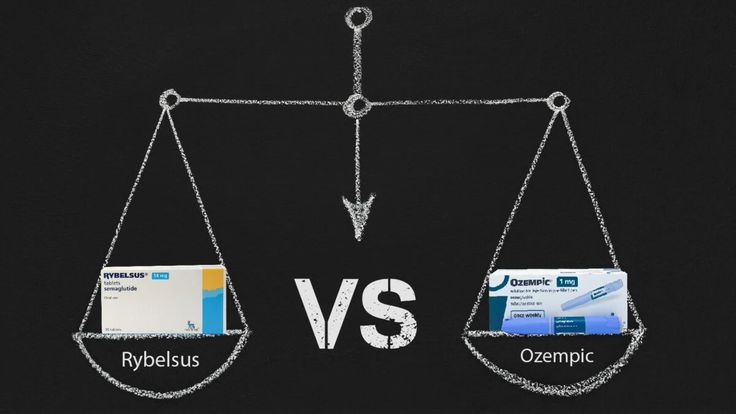Given the increasing interest in these drugs for weight reduction, especially among individuals aiming to manage their diabetes and lose weight at the same time, it is vital to comprehend how each drug works, its advantages, and potential disadvantages. This article explores the ins and outs of each medication, supported by user experiences and clinical data, to clarify its functions in both glucose regulation and aiding in weight reduction objectives. GLP-1 receptor agonists, such as Ozempic and Rybelsus, are a class of medications used mainly to treat type 2 diabetes by assisting in blood sugar regulation. Still, their advantages go beyond glycemic management. Ozempic is an injectable drug that needs to be injected once a week using a prefilled pen. The active component, semaglutide, is a synthetic version of the incretin hormone GLP-1 that the body naturally produces. When blood sugar levels are raised, this hormone is crucial for triggering the production of insulin. Many people use Ozempic for two purposes since, in addition to its primary usage, it has been observed to have a considerable impact on weight loss. Rybelsus is a revolutionary development. It is the first oral version of semaglutide to be marketed. It has the same active component as injectable GLP-1 receptor agonists but in the handy form of daily pills. Comparably to Ozempic, Rybelsus functions by increasing insulin secretion, decreasing glucagon production, and postponing stomach emptying all of which improve blood sugar regulation and may even help with weight loss. By lowering hunger and food intake, these drugs not only help with glycemic control but also significantly aid in weight loss. This is especially advantageous for people trying to control both diabetes and obesity. Because of their complementary actions, Ozempic and Rybelsus are essential components of the type 2 diabetes treatment plan, providing options to suit a range of lifestyles and patient preferences. Improving insulin secretion and decreasing appetite two crucial functions that aid in weight loss are the intriguing and powerful mechanisms by which Ozempic and Rybelsus work. These dual approaches are important options for individuals who want to accomplish both goals since they help control type 2 diabetes and weight management. Is Ozempic or Rybelsus Better for Weight Loss? Investigating the mechanisms underlying these drugs' actions is crucial. Both medications work by simulating the actions of the incretin hormone GLP-1, which the intestines normally produce following a meal. One of the main ways that GLP-1 affects glucose metabolism is by: Increasing the release of insulin: GLP-1 causes the pancreas to secrete more insulin in response to an increase in blood sugar. Because more insulin makes it easier for sugar to enter cells and be used as fuel, blood glucose levels are lowered. Inhibiting glucagon secretion: GLP-1, a hormone that induces the liver to release glucose stored in the body's tissues into the bloodstream, inhibits glucagon secretion. Ozempic and Rybelsus reduce blood sugar levels by inhibiting glucagon. Slowing gastric emptying: Both drugs to prolong the feeling of fullness that follows a meal. This process aids in decreasing hunger and calorie consumption, both of which are essential for weight loss. Direct effects on the brain: GLP-1 receptors are also present in the brain, where they support the control of hunger and fullness. Ozempic and Rybelsus can activate these receptors to reduce appetite and encourage a lower calorie intake . Because of its greater dosage of semaglutide and administration method, Ozempic typically exhibits a more dramatic impact than Rybelsus in aiding in weight loss. At the same time, individual differences in effectiveness do exist. However, a patient's desire for an injection over an oral prescription, their lifestyle, and the way their body reacts to the treatment all play a role in which drug they ultimately choose between Rybelsus and Ozempic. With robust mechanisms of action that bolster their usage in clinical practice, both drugs are effective tools for managing type 2 diabetes and aiding in weight loss. Several clinical investigations have shown that Ozempic and Rybelsus can both successfully encourage weight loss, highlighting their usefulness beyond glucose control in individuals with type 2 diabetes. The effectiveness of these drugs in aiding weight loss significantly impacts the management of obesity, a prevalent comorbidity in individuals with diabetes. Clinical Studies: Subjects taking Rybelsus or Ozempic reported significant weight losses. These studies usually include overweight or obese people with type 2 diabetes, and they assess the effects of weight loss in addition to blood sugar improvements. Based on clinical research, it has been demonstrated that the weight reduction resulting from these medications is not just a consequence of better diabetes control but also a direct result of the drugs' processes of appetite suppression and calorie restriction. Comparison: Ozempic and Rybelsus both have good effectiveness rates; however, meta-analyses and comparative studies indicate that Ozempic may provide a slightly greater reduction in body weight. This discrepancy is frequently explained by semaglutide's increased systemic exposure and absorption when given as an injectable solution (Ozempic) as opposed to an oral tablet (Rybelsus). The drug's efficacy may vary depending on how it is delivered; injectable formulations often offer a more concentrated and direct dosage of the drug. Additionally, compared to the usual dosage for Rybelsus, Ozempic used for weight loss in clinical settings may be administered at a larger dose. This larger dosage may explain the greater weight loss seen in certain patients. In a side-by-side comparison, for instance, patients receiving Ozempic treatment reported weight losses of up to 10% on average. In contrast, Rybelsus users experienced somewhat smaller average weight losses, at about 8%. When deciding between Ozempic and Rybelsus for weight loss, a patient's lifestyle choices, tolerance to injections as opposed to oral drugs, and individual health objectives should all be taken into account. Both drugs are useful in the management of type 2 diabetes and obesity; the choice should be based on the needs of the patient as well as professional recommendations. Although controlling blood sugar levels and encouraging weight reduction are two benefits of Ozempic and Rybelsus, it is important to take into account their adverse effects, as they may affect patient compliance and the overall efficacy of treatment. Patients and healthcare professionals can make educated judgments about diabetes treatment and weight reduction techniques when they are aware of these negative effects. For both Rybelsus and Ozempic, gastrointestinal side effects are the most commonly reported side effects. Among these are possible examples: Nausea: Many people feel nausea as their bodies get used to the medicine. This side effect is usually transient and may become less severe with time. Diminished appetite: Although helpful in reducing body weight, this can also pose difficulties if it results in insufficient nourishment. Pain and discomfort in the abdomen: These symptoms may appear when the body adjusts to the higher GLP-1 levels. Diarrhoea or constipation: Bowel movement abnormalities are typical, and individual differences can be observed. As the body adjusts to the medicine over the course of weeks to months, these adverse effects, which are typically mild to moderate, usually improve. Although they are uncommon, Ozempic and Rybelsus might cause more serious side effects that need to be treated right away. These include: Pancreatic inflammation, or pancreatitis: Patients should look for intense stomach discomfort as a possible sign of pancreatitis. If anything is dubious, it's critical to get in touch with a healthcare professional right away. Kidney problems: Patients who already have kidney disease or are taking other medications that impact renal health may find that these medications negatively impair kidney function. Changes in urine production, ankle or foot oedema, and unusual weariness are all possible indicators of renal issues. Problems with the gallbladder: Gallstones have been reported, particularly in people who have lost a lot of weight. It's also important to remember that, according to research on animals, there may be a risk of thyroid C-cell tumours with these drugs. There is constant surveillance in this area, even though it is uncertain if individuals are at risk. Patients should discuss any possible side effects with their healthcare professional before using Ozempic or Rybelsus to ensure they are making the optimal decision for their health profile and treatment objectives. Monitoring side effects and modifying the treatment plan as needed is an important part of controlling the dangers related to these drugs. To achieve the best possible results in managing your diabetes and losing weight, it's imperative that you comprehend the dosage and administration directions for Rybelsus and Ozempic. These drugs vary not only in form but also in how they are administered, which may impact patient choice and treatment compliance. Ozempic is given as a weekly subcutaneous injection. To simplify the injection process, the drug includes prefilled, single-use, disposable pen injectors with prefilled cartridges. To reduce gastrointestinal side effects, patients usually start with a lower dose. Based on the patient's tolerance and glycemic reaction, the dose may then be progressively increased. By giving the medication in small doses, this systematic approach reduces the possibility of adverse effects and enhances patient comfort as they get used to it. Starting Dosage: Typically, 0.25 mg per week is used as the starting dose for treatment. Maintenance Dosage: Depending on the patient's needs and the clinical response, the dose may be increased to 0.5 mg per week after a month or as prescribed by a healthcare professional. If necessary, it may be further adjusted to 1.0 mg or more. When higher doses are taken, the flexibility in dosing allows the prescription to be customized to each patient's needs, which is advantageous for controlling blood sugar levels and contributing to noticeable weight loss. Rybelsus is an enticing alternative for people who would rather not use injectables because it is the first GLP-1 receptor agonist available as a tablet. The tablet should be taken orally once a day, ideally half an hour before breakfast. To guarantee that the medication is absorbed correctly, it should be consumed whole with no more than 4 ounces of water. No other food, drink, or medication should be taken during those 30 minutes. Initial Dosage: 3 milligrams is usually the starting dose. Maintenance Dose: Following a few weeks, the dose may be raised to 7 mg and, if necessary, to 14 mg per day, contingent on the patient's response and tolerance. Because Rybelsus must fit into a patient's daily routine, the requirement to take it on an empty stomach and wait before eating can be a key factor in patient compliance. In addition to helping patients lose weight, Ozempic and Rybelsus both provide efficient type 2 diabetes treatment. Individual preferences, lifestyle factors, and specialised medical advice will all play a role in the decision between an injectable and an oral GLP-1 receptor agonist. Proper administration is essential for optimising therapeutic advantages and minimising adverse effects. In summary, the discussion on "Is Ozempic or Rybelsus better for weight loss?" shows that both drugs have a lot to offer in terms of helping people lose weight and treating type 2 diabetes. However, selecting between Ozempic and Rybelsus is not a one-size-fits-all decision and needs to be carefully reviewed in light of a number of important considerations. 
Both Rybelsus and Ozempic, which were created to treat type 2 diabetes, are becoming more widely known for their ancillary advantages in helping people control their weight. GLP-1 receptor agonists like these drugs not only assist control of blood sugar levels but also have a great deal of potential to help patients lose weight, which is a typical problem for those with diabetes. This extensive comparison seeks to determine which medication Ozempic or Rybelsus is more helpful at promoting weight reduction. Based on factors like cost, side effects, convenience of use, and effectiveness, it may be able to assist patients and healthcare professionals in making more informed decisions. What do Rybelsus and Ozempic mean?
The mode of action

Effectiveness in Reducing Weight

Effects on the Side
Common Side Effects
Severe Side Effects
Ratio and Handling

Ozempic
Rybelsus